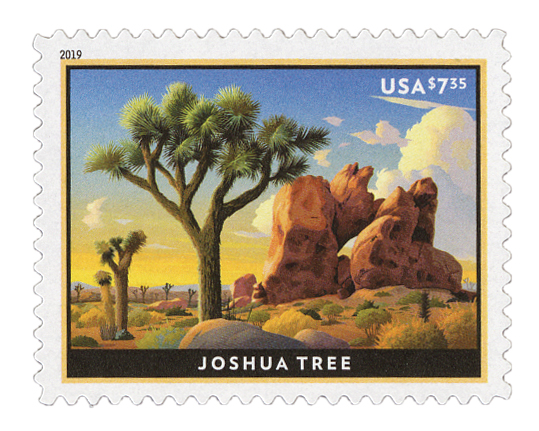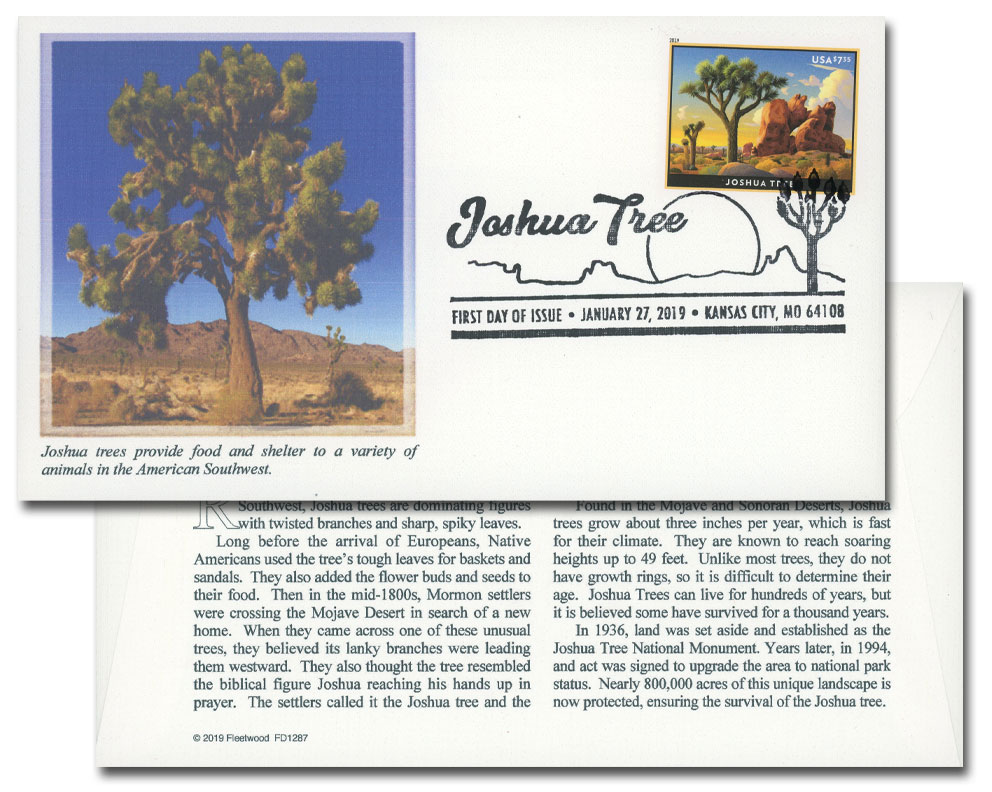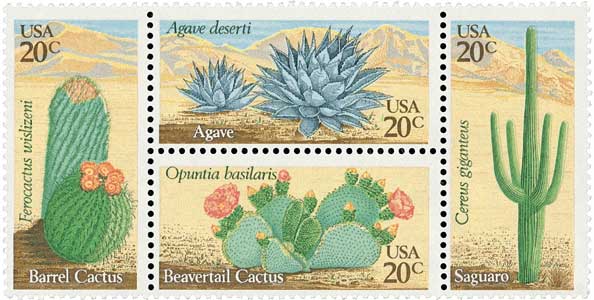
# U698 - 2018 $7.35 Priority Prestamped Envelope- Joshua Tree
Own Stamped Envelope First Day Cover Featuring 2019 Joshua Tree Priority Mail Stamp
Joshua Tree National Monument

On August 10, 1936, President Franklin Roosevelt used the power of the 1906 Antiquities Act to create Joshua Tree National Monument.
Rising tall above the sand dunes in the American Southwest, Joshua trees are dominating figures with twisted branches and sharp, spiky leaves. Found in the Mojave and Sonoran Deserts, Joshua trees grow about three inches per year, which is fast for their climate. They are known to reach soaring heights, up to 49 feet. Unlike most trees, they do not have growth rings, so it is difficult to determine their age. Joshua trees can live for hundreds of years, but it is believed some have survived for a thousand.

Long before the arrival of Europeans, Native Americans used the tree’s tough leaves for baskets and sandals. They also added the flower buds and seeds to their food. The Pinto Culture, Serrano, Cahuilla, Chemehuevi, and Mojaves all lived in or near the area of the present-day park.

The first known Europeans to see the Joshua trees were members of Pedro Fages Spanish expedition in 1772. In the mid-1800s, Mormon settlers were crossing the Mojave Desert in search of a new home. When they came across one of these unusual trees, they thought the tree resembled the biblical figure Joshua reaching his hands up in prayer. The settlers believed the branches were guiding them westward. They named the tree after Joshua, and it has been called that ever since.

Beginning in the 1870s, settlers began to occupy the area, establishing cattle ranches. Around the same time, miners also flooded the region to work about 300 pit mines. One of them, the Lost Horse Mine, yielded about $5 million in modern currency’s worth of gold and silver. By the late 1920s, new roads brought more developers to the area as well as cactus collectors. People came to the area and removed cactuses to take back to their gardens in Los Angeles.

Minerva Hoyt was a wealthy socialite who used her influence to support civic causes. She was especially upset by this practice of people removing cacti, Joshua trees, and other plants from the area. People even burned the trees to serve as signals at night. Hoyt began calling for federal protection of the area. She arranged exhibitions of desert plants in Boston, New York, and London to raise awareness. She also established the International Deserts Conservation League.

In 1927, Frederick Law Olmsted Jr. of the California State Park Commission asked Hoyt for ideas for desert state parks. She suggested a one-million-acre park. Though it wasn’t adopted as she suggested, some of the area were made into state parks. After the governor of Baja California in Mexico proposed creating a desert park, Hoyt suggested creating an international park on the US-Mexico border. This idea was also not adopted, but in 1931, Mexico named a newly discovered species of cactus after her. The Mexican president also announced a 10,000 acre cactus forest near Tehuacán would be preserved in honor of the International Deserts Conservation League and Hoyt.

After Franklin Roosevelt’s election in 1932, Hoyt approached Secretary of the Interior Harold Ickes with her idea for a park in the California desert. On August 10, 1936, President Roosevelt created the 825,000-acre Joshua Tree National Monument. The park’s size was decreased by 265,000 acres in 1950 to remove mining properties.

In the 1980s, California Senator Alan Cranston submitted the California Desert Protection Act to help better protect desert parks from tourism, mining, grazing, automobiles, and commercial and residential development. After he retired, Senator Dianne Feinstein continued to promote the bill, which was signed into law on October 31, 1994. That bill upgraded Joshua Tree to a national park and added 234,000 acres to it that would help to better protect its resources. The park was expanded by another 4,518 acres in 2019.
Click here for photos and more from the park’s official website.
Own Stamped Envelope First Day Cover Featuring 2019 Joshua Tree Priority Mail Stamp
Joshua Tree National Monument

On August 10, 1936, President Franklin Roosevelt used the power of the 1906 Antiquities Act to create Joshua Tree National Monument.
Rising tall above the sand dunes in the American Southwest, Joshua trees are dominating figures with twisted branches and sharp, spiky leaves. Found in the Mojave and Sonoran Deserts, Joshua trees grow about three inches per year, which is fast for their climate. They are known to reach soaring heights, up to 49 feet. Unlike most trees, they do not have growth rings, so it is difficult to determine their age. Joshua trees can live for hundreds of years, but it is believed some have survived for a thousand.

Long before the arrival of Europeans, Native Americans used the tree’s tough leaves for baskets and sandals. They also added the flower buds and seeds to their food. The Pinto Culture, Serrano, Cahuilla, Chemehuevi, and Mojaves all lived in or near the area of the present-day park.

The first known Europeans to see the Joshua trees were members of Pedro Fages Spanish expedition in 1772. In the mid-1800s, Mormon settlers were crossing the Mojave Desert in search of a new home. When they came across one of these unusual trees, they thought the tree resembled the biblical figure Joshua reaching his hands up in prayer. The settlers believed the branches were guiding them westward. They named the tree after Joshua, and it has been called that ever since.

Beginning in the 1870s, settlers began to occupy the area, establishing cattle ranches. Around the same time, miners also flooded the region to work about 300 pit mines. One of them, the Lost Horse Mine, yielded about $5 million in modern currency’s worth of gold and silver. By the late 1920s, new roads brought more developers to the area as well as cactus collectors. People came to the area and removed cactuses to take back to their gardens in Los Angeles.

Minerva Hoyt was a wealthy socialite who used her influence to support civic causes. She was especially upset by this practice of people removing cacti, Joshua trees, and other plants from the area. People even burned the trees to serve as signals at night. Hoyt began calling for federal protection of the area. She arranged exhibitions of desert plants in Boston, New York, and London to raise awareness. She also established the International Deserts Conservation League.

In 1927, Frederick Law Olmsted Jr. of the California State Park Commission asked Hoyt for ideas for desert state parks. She suggested a one-million-acre park. Though it wasn’t adopted as she suggested, some of the area were made into state parks. After the governor of Baja California in Mexico proposed creating a desert park, Hoyt suggested creating an international park on the US-Mexico border. This idea was also not adopted, but in 1931, Mexico named a newly discovered species of cactus after her. The Mexican president also announced a 10,000 acre cactus forest near Tehuacán would be preserved in honor of the International Deserts Conservation League and Hoyt.

After Franklin Roosevelt’s election in 1932, Hoyt approached Secretary of the Interior Harold Ickes with her idea for a park in the California desert. On August 10, 1936, President Roosevelt created the 825,000-acre Joshua Tree National Monument. The park’s size was decreased by 265,000 acres in 1950 to remove mining properties.

In the 1980s, California Senator Alan Cranston submitted the California Desert Protection Act to help better protect desert parks from tourism, mining, grazing, automobiles, and commercial and residential development. After he retired, Senator Dianne Feinstein continued to promote the bill, which was signed into law on October 31, 1994. That bill upgraded Joshua Tree to a national park and added 234,000 acres to it that would help to better protect its resources. The park was expanded by another 4,518 acres in 2019.
Click here for photos and more from the park’s official website.







